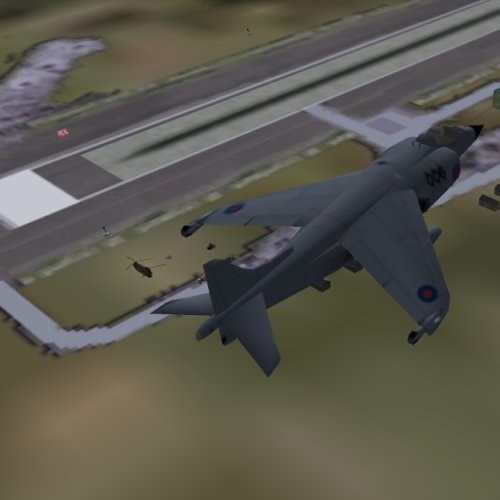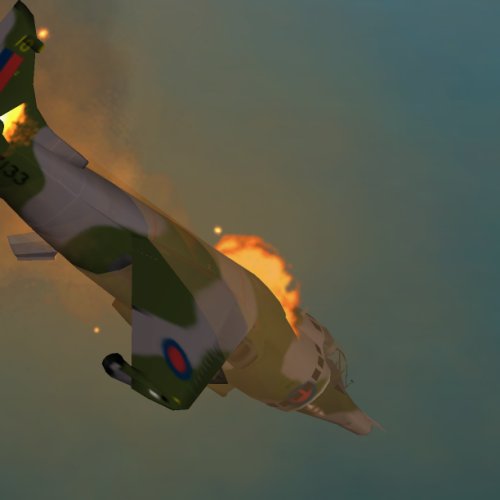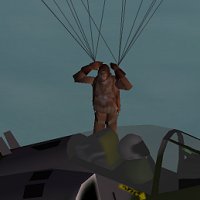MiGMan’s Combat Diary, 2002
I love Harriers. They are noisy aircraft, and they are fun to watch doing their unique 'Harrier moves', like hovering, of course, and even flying backwards.
To VIFF or not to VIFF, that is the question
All the more disappointing then, that this collection of Harriers - nearly 20 of them - can't be flown as Harriers!
For a start the VIFFING doesn't work as expected.
If you do use it it feels like an arcade effect and of course you can't actually hover.
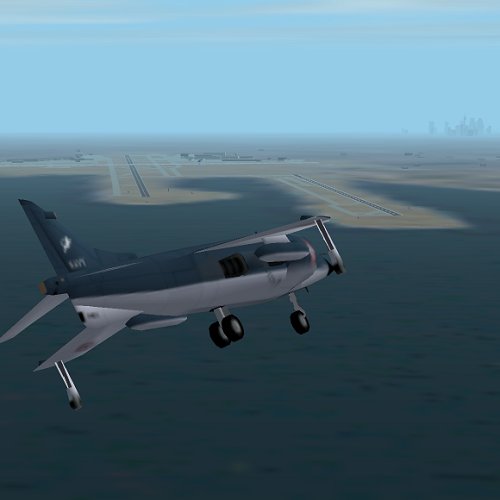
I had more fun flying the fleet as conventional aircraft than as S/VTOL aircraft. Landing here on 35L at Sydney International Airport in Microsoft Flight Simulator 2002.
OK, - so there's still a great collection of Harriers to fly as conventional aircraft, right? Well.. not quite.
The linking of flap settings to the thrust vector makes normal takeoffs and landings very difficult. The Harriers have a suspiciously long glide time for a stubby winged jet, s it can be quite difficult to bleed speed off on final approach - and of course you can't use the flaps or you shoot skywards!

The aircraft I most enjoyed flying was the Pucara.
One of the main advantages the Harrier had over the faster Mirage Daggers and the nimble A-4 Skyhawks was their ability to change the thrust vector in forward flight. By directing the thrust downwards you could pull much tighter turns. Once again - "Due to the limitations of the host simulation" the VIFFING doesn't work. This is a major dissapointment to virtual Harrier pilots!
Even though the manual says NOT to vector thrust over 110 knots I had to try it. What I found was that you do get a terrific boost in the pitch axis by putting the flaps (linked to thrust vector) down just one notch or 20 degrees.
So you can use VIFFING - but it's a kind of all or nothing proposition.
In other Harrier sims like SVGA Harrier Assault (1992) and Harrier Jump Jet (1992) you could vector the thrust in small increments, often leaving it at stage one in a tight turning dogfight.
Weapons (?)
Most (all?) of the Harrier kills during the Falkland War of 2982 were achieved with the AIM-9 Sidewinder.
❝ "Due to the limitations of the host simulation" the AIM-9's won't function as heat seeking missiles in Microsoft Combat Flight Simulator (1998) or Microsoft Combat Flight Sim 2. They function as ballistic weapons - like rockets.
❞ Exocet attacks on the British ships aren't possible for the same reason. And of course neither enemy has SAM defenses.
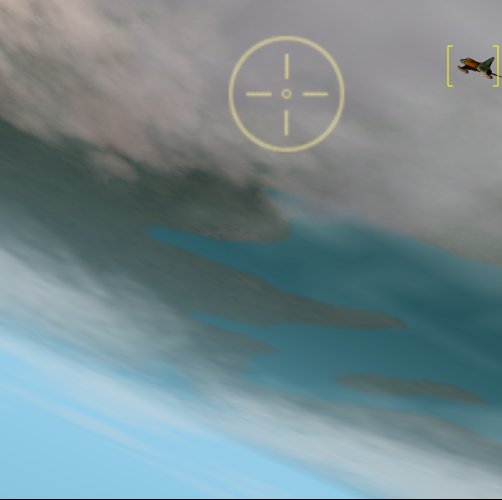
If only I had a sidewinder...
The lack of 3 essential elements in the Harrier dogfight - VIFFING, IR and Radar guided missiles and appropriate countermeasures makes you wonder why bother trying to recreate this scenario? Having said that, I nonetheless had a lot of fun with this package.
Historical note
In 1982 Argentinean troops reclaimed the Falkland Islands, a remote group of islands in the south Atlantic inhabited by a few hundred British subjects.
The British Prime Minister at the time, Margaret Thatcher, responded by sending Vulcan bombers to attack the Argentine positions and then a naval task force with several squadrons of Harriers, some of which operated from the hastily converted decks of cargo ships! By June 14th the 2 month conflict was over and the Union Jack was raised again.
The campaign provided in this package purports to give you a taste of the Falklands War in 1982.
From the air war perspective there are several deficiencies.
Microsoft Combat Flight Sim 2- The campaign missions ran quite well on my Celeron 466 Mk II system. There was only moderate stuttering around areas of high flak - not the devastating frame rate drops seen in other add-ons. The Falkland airbases seemed to be modestly populated by buildings, which helped to keep things flowing along. Aircraft models were simple but adequate, and caused no usual frame rate penalty in external or virtual cockpit views. You really need a CPU around the 1 GHz mark to maintain frame rates over 15 or 20 per second in the custom scenery area.

